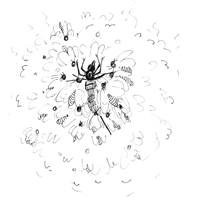STRANGE BUT TRUE- Hot hornet: Bees kill invader with body heat

DRAWING BY DEBORAH DERR McCLINTOCK
Q. The giant hornet Vespa mandarinia japonica invades a hive of Japanese bees upon which it preys, but they will have none of it. Within 20 minutes, the hornet is dead, even though the bees didn't sting, bite, crush or suffocate it. So what is their surprising weapon? –J.D. Aller
A. Body heat. Hundreds of the hive defenders form a huge compact bee ball around the invader and raise their body temperatures from a normal 35C to 48C, says David Halliday in Fundamentals of Physics. This higher temperature is lethal to the hornet but not harmful to the "hot-tempered" bees.
Q. Math teacher asks half her class to flip a coin 100 times, the other half to just imagine doing so. Both record their H-T outcomes. Then she collects the unsigned papers and tries to distinguish the real flippers from the fakers. Any chance she could really do this? –S. R. Aller
A. In The Canon: A Whirligig Tour of the BeautifulBasics of Science, Natalie Angier reports on an elementary statistics prof who starts each semester in just this way. And the prof is almost always right in how she calls them, leaving the students aghast. The reason she can tell is that true randomness is more haphazard than most people think. Real coin tossing will generally include more strings than people are comfortable with, such as streaks of five heads in a row or seven tails in a row.
True, 50-50 rules over the long haul, but not in the short run, and it's the short run where the surprises lie.
When Angier tried the experiment herself a dozen times (12 100-flip trials), she always got at least one streak of six or seven heads or tails, often more than one six per set, plus many fives and fours. Once she even got nine in a row, which she felt queasy about including in a display of faux flipping.
Moral: "The more one knows about probabilities, the less amazing the most woo-woo coincidences become," Angier says.
Q. A taxi company has as its policy to run its cabs with older, well-worn tires and to under-inflate them to boot. Penny-pinching economics, or a pinch of chicanery? –J.T. Graves
A. It's well known that older, worn tires have smaller radii (from maybe 30 centimeters down about 2 percent) and so turn around more times per kilometer or mile, causing the pre-calibrated odometers to over-register and to inflate charges to customers, says Goran Grimvall in Brainteaser Physics. Under-inflated tires will do the same. But the (short-term) winner in this category was the cab driver who reportedly put on smaller-than-customary wheels so as to fatten fares, especially to longer-distance riders. He was later fined for doing so.
Q. Can you recount Winston Churchill's classic line poking fun at critics of phrases like "something not to be sneezed at," "having a lot to answer for," "advice not worth arguing about," "letting everyone know where you're coming from," "laughing one's head off." –J. Brinkley
A. Are you in dread of ending a sentence with a preposition because somebody told you it's not grammatically correct? Well, fear no more, says Mark Davidson in Right, Wrong, and Risky. One dictionary calls this "a cherished superstition," another "an entrenched myth." The silly rule got started in the 17th century and was subsequently circulated by tyrannical scholars and grammarians.
Sir Winston Churchill is said to have become so annoyed by terminal prepositional overzeal that he scribbled a memo to one of his correcting secretaries: "This is the type of arrant pedantry up with which I will not put."
So, anyone who tells you not to "laugh your head off" but rather to "laugh off your head" may have "a lot to answer for."
Send Strange questions to brothers Bill and Rich at [email protected].
#